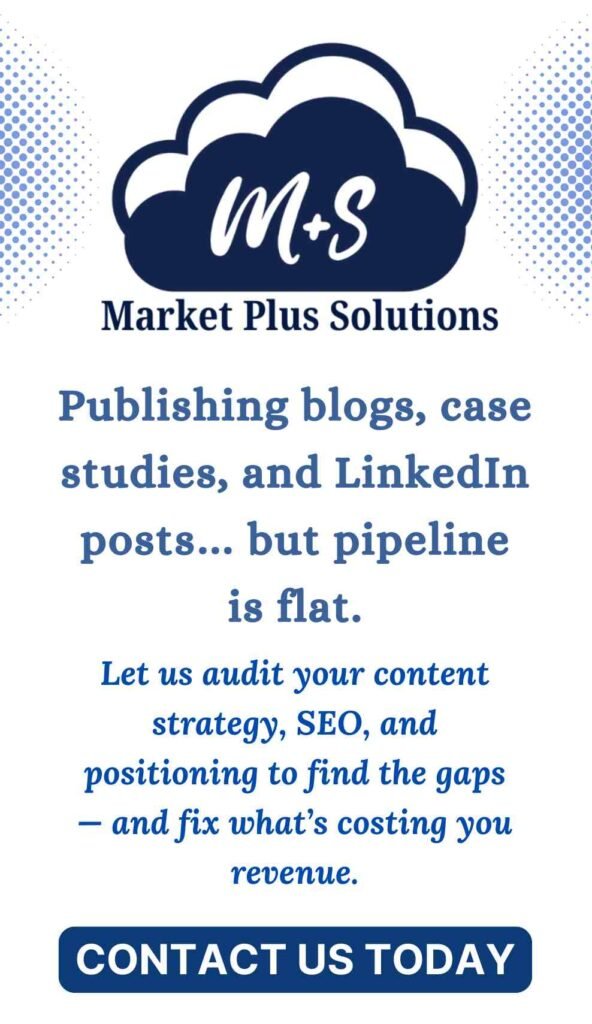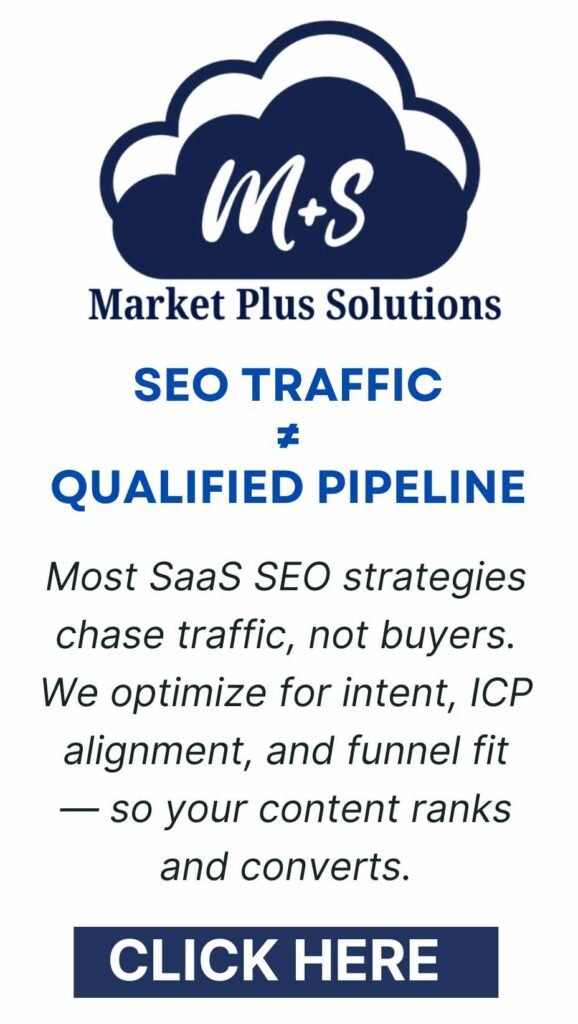Why Content-Led SaaS Marketing Fails to Build Pipeline
SaaS companies aren’t short on content.
They’re drowning in it: Blogs, LinkedIn threads, Case studies, Webinars, Whitepapers, etc.
And, everyone’s publishing.
But almost no one’s breaking through — and pipelines are still running dry.
Here’s the uncomfortable truth: content isn’t a growth strategy. It’s a tactic.
And in most SaaS marketing programs, it’s being overused, misused, and dangerously misunderstood.
The original promise of content marketing was simple: create something valuable, build trust, generate leads. But that promise has become a trap — one where output scales, but revenue doesn’t.
This isn’t a content problem. It’s a context problem.
Most B2B SaaS marketing teams are stuck in execution mode — publishing with no positioning, no point of view, no strategic spine to hold it together. Just assets. Just activity. Just noise. (Click Here if you’re interested in learning: Why Google AI Mode Is a Threat to Businesses That Depend on Organic Traffic)
A staggering 90% of SaaS companies leverage blogs in their growth strategies, yet only about 30% report that their content marketing is truly effective. But, when done well, B2B SaaS brands that invest in content marketing report up to 400% growth in lead generation compared to those that don’t (Source: Mailmodo)
And when there’s no sharp narrative, no intentional distribution, no clear buyer journey? Even the most beautifully crafted content falls flat.
You don’t need more traffic.
You need resonance — content that speaks to decision-makers in real time, solving real problems, with real urgency.
Because effective SaaS marketing isn’t about pushing more out into the world. It’s about saying the right thing, to the right person, at the exact moment they’re ready to hear it — and using that to drive qualified pipeline and true SaaS demand generation.
If your content isn’t doing that?
You’re not building momentum. You’re just fueling a treadmill — and hoping it somehow leads to growth.
Why Content-Led SaaS Marketing Fails More Often Than It Works
Ask most SaaS founders how they’re generating leads, and you’ll hear the same recycled playbook: “Publish more content. Drive traffic. Convert users.”
On paper, it sounds strategic. Scalable and predictable. But in practice? It fails more often than it succeeds.
Here’s the uncomfortable truth: most content marketing for SaaS doesn’t move the needle.
Yes, it ranks — attracts clicks — fills dashboards with activity. But when it comes time to convert real buyers — especially in high-consideration, multi-stakeholder B2B SaaS sales — the results are often underwhelming, if not invisible.
The root issue isn’t content itself. It’s the way SaaS marketing teams confuse activity with effectiveness.
- They write for search engines instead of actual decision-makers.
- They chase keywords instead of solving critical buyer problems.
- They ship content to hit monthly publishing quotas — not to create commercial impact.
Publishing becomes the point — not pipeline.
And that’s where even well-funded teams quietly break. They produce endless guides, blogs, webinars, and case studies, but none of it is anchored to a cohesive SaaS growth strategy.
There’s no unified narrative — no mapped buyer journey — no content tied directly to revenue outcomes. Just output — unconnected, unprioritized, and unmeasured.
In that strategic vacuum, content turns into a checkbox.
A treadmill of deliverables, a machine that’s running full speed — but going nowhere.
Here’s the reality: Without sharp positioning, clear messaging, and a functioning SaaS demand generation engine, content — no matter how beautifully designed or technically optimized — is just noise.
And noise doesn’t close deals.
Effective SaaS marketing isn’t about publishing more. It’s about doing what actually moves the needle — with surgical clarity, commercial focus, and strategic intent.
What Most SaaS Marketing Teams Get Dangerously Wrong
The problem isn’t that SaaS companies aren’t investing in marketing. It’s that the investment is fragmented, unfocused, and built on shaky foundations. (Looking for Best SaaS SEO Agency? Click Here)
Most B2B SaaS marketing teams are drowning in motion — content calendars packed, campaigns running, dashboards glowing with surface-level metrics. But beneath the busyness lies a brutal truth: the system is broken. There’s no cohesion, no strategic center, and no alignment between teams tasked with growth.
And that’s exactly where everything starts to fall apart.
The Real Fault Lines in Modern SaaS Marketing
- Misaligned Teams: Marketing drives awareness. Sales targets entirely different personas. Product ships features with no connection to the buyer journey. Everyone is executing — but no one is orchestrating. No shared view of the customer. No unified strategy across functions. No one truly owns the full funnel. In today’s environment, this level of fragmentation doesn’t just slow you down — it kills conversion velocity.
- Lack of Positioning: If your ICP is “any company that wants to grow,” your SaaS marketing is already set up to fail. When your message tries to speak to everyone, it speaks to no one. This is more than a brand issue — it’s a pipeline problem. Even the best content marketing for SaaS can’t compensate for unclear positioning. Without relevance and specificity, your content fills your funnel with the wrong people — or worse, with no one at all.
A recent LinkedIn study revealed that around 90% of SaaS marketing strategies fail outright, collapsing under misalignment, lack of buyer insight, and executional chaos (Source: LinkedIn).
- The MQL Obsession: A form fill is not intent. A whitepaper download is not a buying signal. Yet many SaaS teams continue to chase vanity metrics, convinced that volume equals velocity. It doesn’t. You’re left with bloated funnels, sales teams chasing ghosts, and marketing dashboards that show “success” while revenue stagnates.
- Zero Differentiation: “AI-powered,” “Scalable,” “Customer-first.” Everyone’s saying the same thing — and buyers have tuned it all out. If your homepage copy could be swapped with a competitor’s and still make sense, you don’t have positioning — you have wallpaper. In oversaturated SaaS categories, sharp differentiation isn’t optional. It’s survival.
- Disconnected Execution: Campaigns are launched in silos. Sales and marketing operate on different timelines. Product lives in a separate universe. No integration — No message consistency. No content tied directly to commercial outcomes. This isn’t strategy. It’s chaos disguised as momentum. And in that chaos, even great content gets wasted — not because it’s weak, but because it’s floating inside a system with no structure.
The Fix? Stop Performing. Start Converting.
What happens in this kind of marketing environment?
- Funnels fill with the wrong leads.
- Sales burns time on dead-end conversations.
- Marketing hits KPIs that never touch revenue.
It’s not just inefficient, it’s expensive. And it’s the opposite of effective SaaS marketing.
To fix it, you don’t need a better blog. You need a strategy that aligns positioning, targeting, messaging, content, distribution, and measurement — a system that treats content as a growth driver, not just a deliverable.
Because without that foundation, your content isn’t building pipeline. It’s just brand theater — and theater doesn’t scale.
Why Content Alone Fails in Modern SaaS Marketing
Let’s get one thing straight: content still matters.
But the way most SaaS companies execute content marketing today? It’s fundamentally broken.
Blog posts get published — eBooks are gated — Webinars go live.
But the funnel stays weak. Pipeline remains thin and revenue barely moves.
Why? (Learn more about: First-Party Data Marketing and why SaaS companies should focus on First-party data and not buy third-party data to grow business)
Because content — by itself — is not a strategy — it’s a tactic. And in most SaaS marketing teams, that tactic is being deployed without context, coordination, or a clear endgame.
You can’t patch over weak positioning or a misaligned go-to-market motion with a library of blog posts and SEO guides. Not in this market or with this buyer.
Today’s decision-makers are smarter, faster, and more skeptical than ever. They don’t want more noise. Instead, they want signal — and SaaS marketing that delivers answers, clarity, and trust. For content to actually move the needle in B2B SaaS, it needs to live inside a sharper, smarter growth strategy — one that connects the dots between buyer intent, positioning, messaging, and revenue impact.
Just 8% of companies report true alignment between sales and marketing—yet this elite group experiences 38% higher win rates and 20% faster annual growth (Source: Improvado)
The System That Turns Content Into Revenue
When content is tied to real strategy, it doesn’t just generate traffic — it drives pipeline.
Here’s what that looks like in practice:
1. Clear ICP Targeting
If your content is “for everyone,” it will convert no one. You need to define your ICP with surgical precision: the industry, the role, the exact pain point. Then speak directly to that buyer, in their language, at their stage of awareness. Generic content attracts generic traffic. Specific content drives real buyers.
2. Precise, Problem-Led Messaging
Good content informs. Great content challenges assumptions, reframes problems, and changes how buyers think. It doesn’t just talk about features — it makes the pain of inaction visible. It pushes readers toward a decision.
3. Intent-Driven Distribution
Distribution isn’t a checkbox — it’s a growth lever. Not everything belongs on your blog. Some pieces should live on LinkedIn. Others in sales enablement hubs. Others in dark social or 1:1 outreach. You don’t need more eyeballs. You need the right ones — at the right time, in the right place.
4. Cross-Functional Alignment
SaaS marketing doesn’t win in silos. When content, product, and sales share insights, goals, and metrics, every touchpoint becomes more powerful. That’s how you build messaging that’s consistent, compelling, and conversion-focused.
When these four elements work in harmony, content becomes a force multiplier. It accelerates deal velocity. It equips sales. It educates buyers in context.
But when even one piece is missing?
Three out of four B2B SaaS marketers stop running paid media before the average 3–12 month sales cycle completes (Source: Tiller Digital)
Content becomes noise — well-designed, keyword-optimized, expensive noise. So ask yourself:
- Is your content showing up in sales conversations?
- Is it driving qualified opportunities — or just traffic?
- Is it tied to strategy, or floating in isolation?
If the answer is no — you don’t have a content problem. You have a SaaS marketing problem.
What Actually Drives Growth in SaaS Marketing
If your funnel’s flat, more blog posts aren’t going to fix it.
A shinier CMS won’t move your pipeline. And pushing volume without direction? That’s just noise at scale.
The SaaS marketing teams driving real growth aren’t the ones creating the most content — they’re the ones engineering content systems built to generate revenue. Every asset has a purpose. Every purpose ties back to pipeline. And nothing gets published unless it’s part of a bigger strategic machine.
Here’s what separates teams that scale from those that spin in circles:
1. Ruthless Positioning
Before campaigns, or content, or growth, comes clarity.
Who exactly are you for? What problem do you solve that’s so painful, urgent, or expensive it demands action — now? Why should your buyer care in the first 10 seconds?
High-performing SaaS companies don’t try to speak to everyone. They zoom in on one critical pain point and own it completely. Their SaaS marketing strategy begins with brutal specificity — and from that, everything flows. Relevance isn’t a creative angle. It’s a prerequisite. Without it, even the most polished content will land flat.
2. Demand-First, Not Lead-First
Traffic is cheap. Leads are easy.
But real demand — intent-rich, sales-ready demand — is earned.
Modern SaaS demand generation isn’t about stuffing a funnel. It’s about reshaping how buyers think before they ever enter one. That means reframing the problem, educating without expectation, and showing up where your buyers already are — with content that actually helps.
You’re not chasing clicks. You’re building belief. And belief converts.
3. Content That Sells, Not Just Publishes
If your content isn’t influencing real conversations — it’s not marketing, it’s decoration.
SaaS marketing content should support the revenue engine directly. That means:
- Competitive pages that win deals in head-to-head evaluations
- Objection-killing assets embedded into sales sequences
- Use-case content built for closing, not just discovery
Content should do more than generate traffic. It should enable sales, shape perception, and move deals forward. Otherwise, it’s just expensive noise.
4. Distribution That Hits the Right People
Reach means nothing if it’s the wrong audience. The smartest SaaS marketers don’t chase impressions — they engineer precision. That means account-based everything:
- Highly targeted ABM ads
- Strategic content drops into Slack groups and email threads
- Personalized 1:1 assets that spark conversations with the right buyers
Distribution isn’t an afterthought.
It’s a growth lever — and it only works when it’s intentional, surgical, and owned.
When these elements work in unison — sharp positioning, trust-first demand gen, revenue-aligned content, and precision distribution — your SaaS marketing stops being noise.
It becomes momentum and converts passively interested readers into ready buyers. It also shortens cycles and increases win rates, and fuels real growth. Because this is what modern SaaS marketing actually looks like:
Not more assets. Not more noise. A system that turns strategy into pipeline — at scale.
Conclusion: Why SaaS Marketing Needs a Strategy—Not Just More Content
The SaaS world isn’t starved for content. In fact, it’s oversaturated.
Every week, companies churn out more blog posts, more gated eBooks, more whitepapers that collect dust in someone’s downloads folder. So, what the industry truly needs is not more material. (Interested in SaaS SEO Service? Click Here)
It needs a smarter SaaS marketing strategy — one rooted in clarity, focus, and measurable relevance.
Most teams aren’t falling short because they’re not producing enough. They’re falling short because they’re producing too much — with no alignment, no direction, and no real connection to what actually drives revenue. It’s movement without traction. Activity without intention.
Let’s be clear: content marketing isn’t broken. What’s broken is how it’s been deployed — expected to shoulder the full burden of growth without the necessary strategic foundation underneath it.
Content can’t fix weak positioning — it won’t clarify a diluted message — it cannot salvage a go-to-market motion that’s fundamentally misaligned with your buyers or your category.
But when those fundamentals are in place — when your SaaS marketing approach is built around sharp positioning, a defined ICP, cross-functional alignment, and a unified demand generation engine — that’s when content finally does what it was always meant to do: amplify what works.
It becomes a multiplier — not a placeholder. A growth asset — not a box to tick.
So if your content isn’t driving qualified pipeline… or if it’s not accelerating sales conversations or educating real buyers at critical moments… or if it’s not helping your go-to-market team close deals faster and smarter…, then it’s not effective SaaS marketing. It’s just performance theater with good formatting — and performance theater doesn’t scale.
The solution isn’t to throw content out the window. It’s to fix the system behind it — so your content finally has something meaningful to support. Because content doesn’t create demand. But strategy does.





